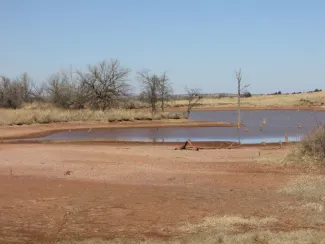Pond leaks can spring for a number of reasons, including natural occurrences, the age of outlet pipe or drain structures, or even inadequate construction. The best way to avoid a leaky pond is to properly build one from the start, but even a well-constructed pond may develop leaks as it ages. Some newly constructed ponds can appear to leak severely just after construction, but this is likely due to the soil needing time to completely saturate and swell to seal against leaking.
Tree roots, ground shifting, or critters that dig into the banks or dam can also cause problems. Most of these leaks can be prevented with proper maintenance, though some things can go unnoticed. If you see a small drop in the water level it may not indicate a leak at all. Evaporation and seepage can result in a slight drop, especially in warmer climates. During the warmer months and in times of lower humidity, a pond may lose over a quarter of an inch of water in a day. If the pond doesn’t have a continuous water supply, this can be noticeable over time. Water losses over 12 inches may indicate a leak, however, and should be investigated. During droughts, the water level may drop significantly and the exposed sides may crack as they dry out, leaving them vulnerable to leaks when the pond refills.

Low pond levels may indicate a problem, such as a leak. Evaporation, seepage, and extended periods of drought can all play a role.
The first step in repairing a leak is to locate the area where the water is escaping. Common areas to look at are any outlet pipe or drain structures to ensure they are still intact. These structures can corrode with age and are likely areas for leaks to form. Look closely at the outer areas of banks and dams to see if there are damp spots where water may be escaping through holes in the pond itself; many times indicated by the presence of water-loving plants growing where there usually isn’t water. Inert food-grade dyes can also be used to locate potential leaks. One indicator is a rapid loss of water down to a certain level. In this scenario, the leak can usually be identified around the banks of the pond with a thorough inspection.
A surefire way to fix a leaking pond or to fix a leak that hasn’t been located is to drain the pond and compact the existing soil, provided there is a good mix of clay. If the existing soil is too coarse, clay should be added in layers from 6 inches to one foot thick. The exposed soil should not be allowed to dry or freeze as this can lead to cracking and potential leaking. Chemical additives can be used but most require the pond be drained and dry to be mixed into the existing soil then compacted again. The cost of all of these solutions vary based on availabilities and have varying rates of success.